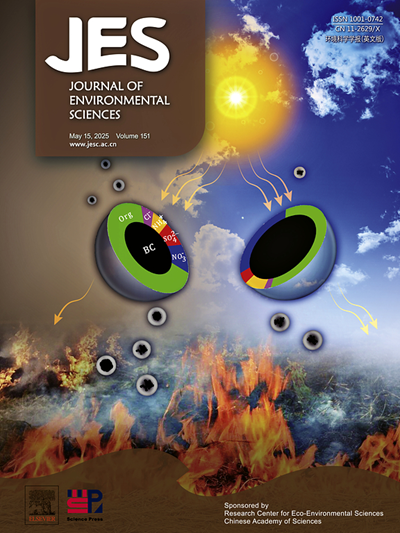In situ engineering 2D/3D CuCo2S4@Co3O4 heterojunction for sensing and photocatalytic degradation of diclofenac sodium in environmental water
IF 5.9
2区 环境科学与生态学
Q1 ENVIRONMENTAL SCIENCES
引用次数: 0
Abstract
Accurate determination and rapid degradation of organic pollutants are essential works in environmental improvement. Herein, the CuCo2S4@Co3O4 heterojunction with fascinating 2D-on-3D hierarchical nanoflowers architecture and highly distributed interface sites were successfully synthesized by CuCo-LDH topological transformation combine with in situ exterior sulfurization strategy. The 2D-on-3D nanoflowers architecture could improve light harvesting ability, provide large surface area, open channels and abundant edge sites. In particular, the intensive M-O-S-M heterojunction interface not only promote the photoexcited charge shuttling but provide abundant interface sites to enhance catalytic activity. As expected, the photocatalytic degradation rate of diclofenac sodium (DCF) on CuCo2S4@Co3O4 was approximately 100% within 30 min under 300 W mercury lamp, which was 1.28 times and 1.45 times higher than that of CuCo-LDH and CuCo2O4. The degradation rate for real samples were more than 80%, the mineralization rate was 90%, and the biological toxicity of degradation products decreased significantly. Furthermore, a novel photoelectrochemistry (PEC) sensor with CuCo2S4@Co3O4 as a photoanode was successfully constructed for directly sensing DCF, showing a wide linear range and satisfactory detection limit. The results indicate that the CuCo2S4@Co3O4 possess dual-functional peculiarity, hold vast potential for sensing and degradation environmental pollutants in wastewater.

环境水中双氯芬酸钠传感和光催化降解的原位工程2D/3D CuCo2S4@Co3O4异质结
准确测定和快速降解有机污染物是改善环境的重要工作。本文通过CuCo-LDH拓扑转化结合原位外硫化策略,成功合成了具有2D-on-3D层次化纳米花结构和高度分布界面位的CuCo2S4@Co3O4异质结。2D-on-3D纳米花结构可以提高光捕获能力,提供大的表面积,开放的通道和丰富的边缘位点。特别是密集的M-O-S-M异质结界面不仅促进了光激发电荷的穿梭,而且提供了丰富的界面位点,从而提高了催化活性。在300 W汞灯下,双氯芬酸钠(DCF)在CuCo2S4@Co3O4上30 min的光催化降解率约为100%,分别是CuCo-LDH和CuCo2O4的1.28倍和1.45倍。对真实样品的降解率达80%以上,矿化率达90%以上,降解产物的生物毒性显著降低。在此基础上,成功构建了以CuCo2S4@Co3O4为光阳极直接检测DCF的新型光电化学(PEC)传感器,该传感器具有较宽的线性范围和较好的检测限。结果表明,CuCo2S4@Co3O4具有双功能特性,在废水中环境污染物的传感和降解方面具有巨大的潜力。
本文章由计算机程序翻译,如有差异,请以英文原文为准。
求助全文
约1分钟内获得全文
求助全文
来源期刊

Journal of Environmental Sciences-china
环境科学-环境科学
CiteScore
13.70
自引率
0.00%
发文量
6354
审稿时长
2.6 months
期刊介绍:
The Journal of Environmental Sciences is an international journal started in 1989. The journal is devoted to publish original, peer-reviewed research papers on main aspects of environmental sciences, such as environmental chemistry, environmental biology, ecology, geosciences and environmental physics. Appropriate subjects include basic and applied research on atmospheric, terrestrial and aquatic environments, pollution control and abatement technology, conservation of natural resources, environmental health and toxicology. Announcements of international environmental science meetings and other recent information are also included.
 求助内容:
求助内容: 应助结果提醒方式:
应助结果提醒方式:


